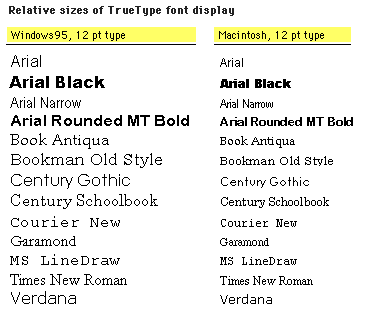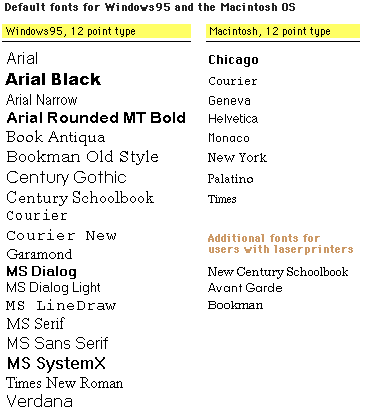Contents
Page Design
|
Introduction Graphic design 100 Balanced pages Design grids for pages Page headers Typography I Typography II Typefaces Consistency Basic Tables Page length Cross platform issues Editorial style Frames Advanced tables Style sheets Miscellaneous |
Until Netscape 3.0, site designers had to accept that their carefully formatted documents would be viewed in any and every typeface, from Times to Tekton. The font was determined by the user's designated browser preferences, and these preferences could not be controlled. However, the most recent version of Netscape has a new tag called <FONT FACE>. You can use this tag to set the font to a common typeface such as Palatino, and this tag will override the user preferences. This is useful not only because of aesthetic partiality, but because of the differing dimensions of typefaces. A table that is carefully designed on one face might not format correctly in another.
|
Table set in Palatino or Times New Roman | ||
|
Lorem ipsum |
Lorem ipsum dolor sit amet | |
| Consectetuer |
Consectetuer adipiscing elit, sed diam nonummy nibh euismod tincidunt ut laoreet dolore magna aliquam erat volutpat. | |
| Iriure dolor in | Iriure dolor in hendrerit in vulputate velit esse molestie consequat, vel illum dolore eu feugiat | |
|
Table set in New York or Century Schoolbook | ||
|
Lorem ipsum |
Lorem ipsum dolor sit amet | |
| Consectetuer |
Consectetuer adipiscing elit, sed diam nonummy nibh euismod tincidunt ut laoreet dolore magna aliquam erat volutpat. | |
| Iriure dolor in | Iriure dolor in hendrerit in vulputate velit esse molestie consequat, vel illum dolore eu feugiat | |
Cross-platform font sizes
The Macintosh and Windows operating systems display type differently, even when the same typefaces are involved. In general, type displayed on Windows Web browsers will look 2 to 3 points larger than the equivalent face on the Macintosh. This difference in font rendering can have a major impact on your page layouts. The table below shows the major Microsoft TrueType typefaces in their 12 point sizes, as displayed in both Windows and the Macintosh:

Specifying particular typefaces
The recent addition of the "FACE" attribute of the "FONT" HTML tag allows you to specify what typeface the browser should use to render type on your Web pages. You can specify the name of any type font in the "FACE" attribute, but in practice you should stick to the most widely used typefaces for the Macintosh and Windows operating systems. If the typeface you specify is not available, the browser will switch to the default font (most often the default font will be "Times New Roman" or "Times").
<FONT FACE="Verdana">Specifying typefaces</FONT>
<FONT FACE="Verdana, Geneva, Helvetica">Typefaces</FONT>

Note that although "Bookman" and "Bookman Old Style" are basically the same typeface, the exact name you specify in the FACE attribute matters. If you want both Macintosh and Windows95 users to see the typeface Bookman, then use both names in your FACE attribute tags:
<FONT FACE="Bookman, Bookman Old Style">Names matter</FONT>
Watch out for tables
If you are using both tables and font tags in your document you should be warned that the combination can be a bit unpredictable. The <TABLE> tag is apparently not allowed inside of a <FONT> tag, which means you will have to include the font settings in each of your <TD> tags. When you are developing your site, set your default proportional font to something obviously different from your intended font. That way you will see clearly whether or not your font settings are being applied to your document.
References
Microsoft Corporation (for Internet Explorer browser) |